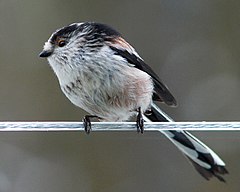Long tailed tit
| Long-tailed tit | |
|---|---|
 |
|
| Perched on a washing line in Shropshire | |
| Scientific classification | |
| Kingdom: | Animalia |
| Phylum: | Chordata |
| Class: | Aves |
| Order: | Passeriformes |
| Family: | Aegithalidae |
| Genus: | Aegithalos |
| Species: | A. caudatus |
| Binomial name | |
|
Aegithalos caudatus (Linnaeus, 1758) |
|
The long-tailed tit or long-tailed bushtit (Aegithalos caudatus), occasionally referred to as the silver-throated tit or silver-throated dasher, is a common bird found throughout Europe and Asia. The genus name Aegithalos was a term used by Aristotle for some European tits, including the long-tailed tit. The specific caudatus is Latin and is derived from cauda, "tail".
The long-tailed tit was first classified as a true tit of the Parus group. Parus has since been split from the Aegithalidae, with the latter becoming a distinct family containing three genera:
This is the only representative of the Aegithalidae in northern Eurasia. The long-tailed tit exhibits complex global variation with 19 races recognised, divisible into three groups:
The silver-throated bushtit was formerly considered conspecific.
Where the groups meet there are extensive areas occupied by very variable ‘hybrids’. The British long-tailed tit, subspecies rosaceus, belongs to the europaeus group. Biochemical evidence has shown Aegithalidae to be closely related to the babblers.
This species has been described as a tiny (at only 13–15 cm in length, including its 7–9 cm tail), round-bodied tit with a short, stubby bill and a very long, narrow tail. The sexes look the same and young birds undergo a complete moult to adult plumage before the first winter. The plumage is mainly black and white, with variable amounts of grey and pink.
Red eye-ring of juvenile, Oxfordshire
Yellow eye-ring of young bird, Oxfordshire
Young adult moulting Oxfordshire
Member of white-headed subspecies
Juvenile on nest
Brood of eight fledglings calling to be fed
The long-tailed tit is globally widespread throughout temperate northern Europe and Asia, into boreal Scandinavia and south into the Mediterranean zone. It inhabits deciduous and mixed woodland with a well-developed shrub layer, favouring edge habitats. It can also be found in scrub, heathland with scattered trees, bushes and hedges, in farmland and riverine woodland, parks and gardens. The bird's year-round diet of insects and social foraging bias habitat choice in winter towards deciduous woodland, typically of oak, ash and locally sycamore species. For nesting, strong preference is shown towards scrub areas. The nest is usually built in thorny bushes less than 3 metres above the ground.
...
Wikipedia

